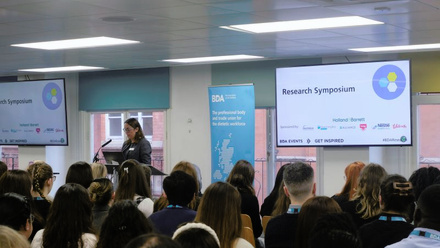Judy Lawrence offers advice about writing an abstract for the BDA Research Symposium and other conferences.

Writing a good abstract is a useful way of telling people about your work and is more likely to get your presentation accepted. However, remember that conference abstracts are different to abstracts for papers.
When submitting an abstract for a conference always make sure that you read any guidance that has been written specifically for that conference. Many conferences publish their proceedings and have quite specific instructions for publishing purposes. Font size, reference style and word counts may be boring and quite irrelevant to the quality of the work, but not conforming to the guidelines may mean that the abstract is not considered for the conference.
The BDA has specific guidance for abstracts submitted to the Research Symposium because the abstracts are likely to be published in the Journal of Human Nutrition and Dietetics. The advice in this article is based on the symposium guidance but should be generally applicable to most conferences if they don’t publish their own instructions.
Title
The title should be short and informative; try to use a single statement rather than hyphenated titles or titles that pose a question. Make the title as accurate as possible and do not be too specific to your locality. It is a good idea to include the type of study.
Names
Anybody who contributed significantly to the project should be an author. Authorship should be discussed with all collaborators prior to submission and the abstract should be approved by all authors prior to submission. If the abstract describes a study that was conducted as part of a dissertation, either for a BSc, MSc or PhD you should discuss the abstract submission with your supervisors and include their name as an author.
Background
This should consist of two or three sentences to set the context of your work and justification for it. Refer to published work, if relevant – this can help to explain why your work is important.
Aim
The aim should be clearly stated at the end of the background, not in the methods. It is helpful to have a sentence that starts “The aim of this research/ service evaluation/literature review was….”, then the reader and any reviewers are absolutely clear what the aim was. The aim is the most critical part of any piece of research because everything else flows from it. Stating the aim clearly can also help you to write the abstract. The most difficult part of writing an abstract is keeping to the word or page limit, if you have a clear aim then anything that does not relate to the aim can be left out.
Methods
State what you did clearly and concisely. Describe the study design (e.g. randomised controlled trial, cross-sectional survey, ethnographic study). Explain what methods were used to put the design into action; for example giving subjects details and how they were recruited helps the reader to understand if there are any biases within the study. The methods used for analysing the results should also come in this section so explain any statistical tests or qualitative analysis and how it was done, for example by using a software package such as SPSS, Excel or NVivo. You may need to spend some time editing this section to include the necessary information in as few words as possible.
Ethics
There should be a statement about ethical approval, including a reference number, if appropriate. If ethical approval was not required for, for example, a service evaluation then include a sentence to that effect. If the project did not need ethical approval but was discussed with an audit and innovation department or similar body and gained their approval then it can be helpful to state this.
Results
Write two or three sentences on your main findings. Tables and figures can be copied and pasted from other programs and may be a space-efficient way of presenting complex results. Tables can also be useful for displaying quotes from qualitative studies. Your results should relate to the aim of your research. If the results are statistically significant give the values to illustrate that but remember clinical significance is not the same as statistical significance and is probably more important in the practice setting.
Discussion
Discuss your findings in two or three sentences. Explain the meaning of your results or say how they compare with what you expected or how they compare with other people’s work. Remember to include a reference when you talk about someone else’s work. This is the place to mention any shortcomings with your work, for example that the sample size was small. All research has problems – it is good practice to acknowledge them and any effects they might have had on the results.
Conclusion
Give your final conclusion in one sentence. Make sure your conclusion is supported by your findings – it is very common to over-emphasise the importance of results. Use the term “suggest” rather than “show” – for example: “the results suggest that…” not: “the results show that…” Go back to your aim and check that your conclusion relates to the aim.
References
In general, a conference abstract should need no more than two or three references. The Research Symposium uses the same referencing style as JHND; number references consecutively in the order in which they first appear in the text using superscript Arabic numerals in parentheses, e.g. “These findings are consistent with previously published data(1)”. References should be listed in a separate section at the end of the paper, in numerical order using the Vancouver system. If an article has more than three authors only the names of the first three authors should be given followed by ‘et al.’ Full referencing guidelines are available on the journal website.
Presentation
Always make sure that any guidelines regarding font, word count, page limit and referencing have been followed. Use whole sentences and appropriate language; for example, although “people with diabetes” uses more words than “diabetics”, it avoids stigma. Get someone to proofread your abstract before submitting it – we all find it hard to spot our own errors. It can also be helpful to enlist help to sense check the abstract. Consider your audience – will the abstract be read by dietitians or a wider audience? Even if the abstract is being presented to a specialist group audience it may be read by dietitians, and others, who are not familiar with some of the issues in a particular specialist area, so avoid using acronyms without first writing the words in full.
Knowledge booster
-
The most important thing is the Aim – everything should relate to it
-
If possible, read previous conference abstracts to get a feel for the expected format
-
For more information about the BDA Research Symposium click here







